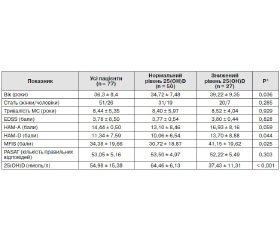Международный неврологический журнал 5 (75) 2015
Вернуться к номеру
Influence of sun exposure and vitamin D status on clinical peculiarities in patients with multiple sclerosis in vinnytsia region
Авторы: Malyk S.L., Moskovko S.P., Kostiuchenko A.V. - Vinnitsa National Medical University MI Pirogov
Рубрики: Неврология
Разделы: Клинические исследования
Версия для печати
multiple sclerosis, sun exposure, vitamin D, depression, fatigue, Vinnitsa region.
Background. Multiple sclerosis (MS) is a chronic demyelinating disease of the central nervous system. In humans, ultraviolet radiation or vitamin D may protect against MS. However, the associations between sun exposure, 25(OH)D levels and common MS symptoms such as depression, anxiety, fatigue and cognitive impairment have received relatively little attention.
Purpose. The purpose of this study was to evaluate the associations between personal sun exposure, serum 25hydroxyvitamin D (25(OH)D) and depression, fatigue, anxiety and cognitive deficits in patients with multiple sclerosis (MS) in population of Vinnitsa region.
Materials and methods. We have analyzed data received from 77 patients with MS. Neurological disability was assessed using the Expanded Disability Status Scale (EDSS) score. Severity of depressive symptoms and anxiety was measured using the Hamilton Rating Scale for Аnxiety (HAM-A) and Hamilton Rating Scale for Depression (HAM-D). Intensity of fatigue was assessed using the Modified Fatigue Impact Scale (MFIS). Cognitive function (particularly auditory information processing speed and flexibility, as well as calculation ability) was measured using the Paced Auditory Serial Addition Test (PASAT). Venous blood sampling was performed for all participants and serum 25-hydroxy Vitamin D was evaluated using High Performance Liquid Chromatography. Mean scores of EDSS, HAM-A, HAM-D, MFIS and PASAT were compared between patients with normal and low serum level of vitamin D. The relationship between higher EDSS, HAM-A, HAM-D, MFIS, PASAT scores and low Vitamin D status was determined. Statistical data processing was performed in the statistical package SPSS 20 (© SPSS Inc.).
Results. The prevalence of anxiety, depression and fatigue was 29.5%, 56.4% and 44.9%, respectively. Their mean scores were 11.34±7.59, 14.44±0.5 and 34.38±19.66, respectively. The mean number of correct answers on PASAT was 53,05±5.16. The mean vitamin D status was 54.98±15.38 nmol/L. The prevalence of low Vitamin D status was 35.1%.
There were no statistically significant differences in 25(OH)D level in depressed and non-depressed patients with MS, and also in patients with chronic fatigue syndrome and without it (p˃0.05). Low Vitamin D status was inversely associated with depressive symptoms in patients with MS (r = -0.251, р = 0.026), fatigue (r = -0.342, р = 0.002) and age (r = -0.248, р = 0.030), but there was no significant correlation between Vitamin D and anxiety or cognitive dysfunction scores (p˃0.05). Self-reported high levels of sun exposure were inversely associated with EDSS scores (r = -0.256; р = 0.024) and less evident depressive symptoms (r = -0.227; р = 0.047) in patients with MS. No associations were found between self-reported sun exposure and anxiety, fatigue or cognitive dysfunction scores.
Conclusion. This study shows a negative correlation between serum vitamin D status and levels of depressive symptoms, fatigue, and age in patients with MS. Self-reported high levels of sun exposure were inversely associated with less evident depressive symptoms in patients with MS in population of Vinnitsa region.

